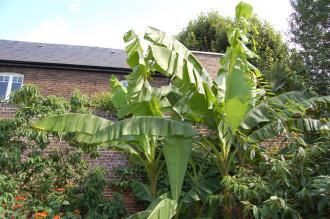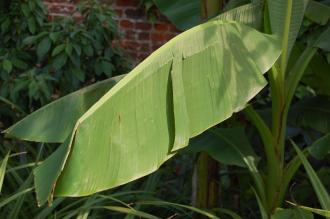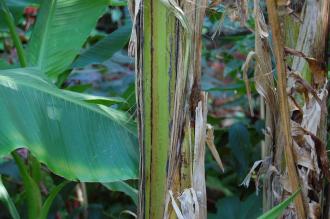
Musa basjoo (17/08/2014, Kew Gardens, London)
Position: Full sun to light shade
Flowering period:
Soil: Moist, well drained
Eventual Height: 4m
Eventual Spread: 3m
Hardiness: 8a, 8b, 9a, 9b, 10a, 10b
Family: Musaceae
Musa basjoo is a fast growing semi evergreen herbaceous perennial with an upright habit. Its mid green leaves are elliptic with entire margins, up to 1.5mm long and 55cm broad. Its yellow/ green trunk is classified as a pseudostem and may achieve a length of up to 2.5m. Its green/ yellow flowers are male and female, appear on the same plant are up to 1m long. Its fruit is an edible banana (when fully ripe), up to 10cm long and 3cm broad. Its roots are rhizomes.

Musa basjoo Leaf (17/08/2014, Kew Gardens, London)
Musa basjoo, commonly known as Japanese Banana, Japanese Fiber Banana or Hardy Banana, is native to south China. Musa basjoo is the hardiness species of this genus.
The etymological root of the binomial name Musa is named after Antonio Musa (63-14 BC), a physician to Emperor Augustus. Basjoo is derived from the Japanese basho meaning banana’.
The landscape architect may find Musa basjoo useful in tropical/ lush style planting schemes. This plant prefers a sheltered position.
Ecologically, Musa basjoo is of little value to UK wildlife.
The Royal Horticultural Society has given Musa basjoo their prestigious Award of Garden Merit in 2002.

Musa basjoo Stem (17/08/2014, Kew Gardens, London)
Musa basjoo prefers moist, humus rich, fertile, well-drained soils. It tolerates most pH of soil. This plant dislikes dry soils.
Musa basjoo requires little maintenance. At the colder end of its hardiness range the above ground part of this plant will die, the rhizome should be covered with thick mulch in late autumn. Old leaves may be removed to keep a tidy appearance. Suckers may be removed and grown on to produce new plants.

